Description
QUESTION 1: (12)
1.1 Hill (2008) identifies different levels of language development in young learners.
1.1.1 Discuss the language development of learners who are at the Early-reading level and explain how the knowledge of these stages will enable teachers to assist learners in developing language in class. (6)
1.1.2 Create TWO (2) activities that you would use to develop language skills for Early-reading level learners.
QUESTION 2: (28)
Phonics involves the linking of the letters of the alphabet to the sounds they make in words (HLT3701 Study Guide 2020).
2.1 Illustrate the strategies of teaching phonics to Grade-1 learners with reference to the stages of teaching phonics. (12)
2.2 Research has shown that most South African primary school learners cannot read with understanding. Pressley (2006) maintains that young readers need to acquire five comprehension strategies to be proficient readers.
2.2.1 Suggest FIVE (5) comprehension strategies that you can apply in your Grade-2 class. (5)
2.2.2 Justify their effectiveness in developing comprehension skills in Foundation Phase learners. (5)
2.2.3 Use practical examples to discuss how a Grade-2 teacher can use the class discussion strategy to develop the comprehension skills of learners.
QUESTION 3: (15)
Read the following scenario and answer the questions that follow:
Mrs Smith, a Grade-3 teacher, always starts a writing task with oral exercises. She also models how to write a story on a chalkboard or a chart. The learners then do their writing. Mrs Smith observes learners while they write and helps them to improve their writing. Once they are done, she asks a few learners to share their stories with the whole class.
3.1 Identify the writing strategy that Mrs Smith uses in the above scenario. (2)
3.2 Evaluate how this strategy can assist learners to develop writing skills. (5)
3.3 Writing can be taught in a series of lessons. Evaluate the importance of teaching writing in a series of lessons with reference to a writing cycle.
QUESTION 4: (20)
Consult the e-reserves.
Castles, A., Rastle, K. & Kate Nation, K. 2018. Ending the Reading Wars: Reading Acquisition From Novice to Expert.
Castles et al (2018) affirm that, for many years, the pendulum has swung between the phonics approach, according to which the sounds that letters make are taught explicitly, and the whole-language approach, which emphasises the child’s discovery of meaning through experiences in a literacy-rich environment.
Apply the knowledge that you have acquired by reading the above article and the study guide to answer the following questions.
4.1 In your own words, distinguish between the phonic approach and the whole-language approach. (6)
4.2 After you have read the article, explain what the reading wars are about. (6)
4.3 Based on the knowledge you have acquired in this module, state which approach you think contributes most to the effective teaching of reading. Advance a strong argument to justify your views.
QUESTION 5: (25)
Read the following statement and follow the instruction below:
The carpet area is where learners sit and engage in interactive activities. Language activities such as shared reading and writing, listening to stories, and learning and performing action rhymes, usually take place in the carpet area.
Plan a lesson that you can teach to your Grade-1 class while you sit on the carpet with your learners. Remember to include the following:
(i) Topic of the lesson (2)
(ii) Purpose of the lesson (2)
(iii) Teaching strategy/strategies (2)
(iv) Assessment strategies (2)
(v) Resources (2)
(vi) Introduction of the lesson (5)
(vii) Presentation (5)
(viii) Conclusion

![INF1505-Multiple Choice (Questions & Answers) [2023]](https://studypass.co.za/wp-content/uploads/2022/12/1-15-300x300.png)


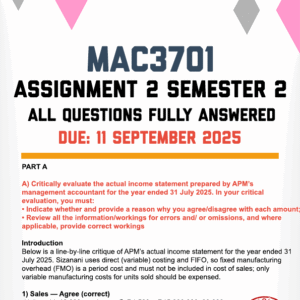





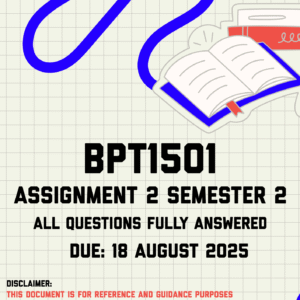








![CIC2601-Multiple Choice (Questions & Answers) [2023]](https://studypass.co.za/wp-content/uploads/2022/12/1-6-300x300.png)









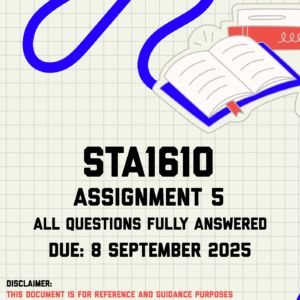



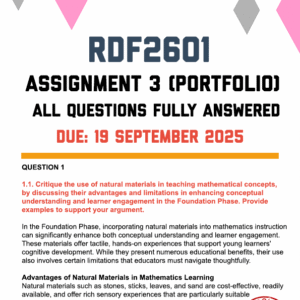





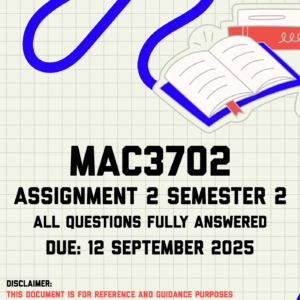
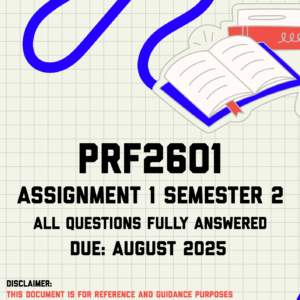





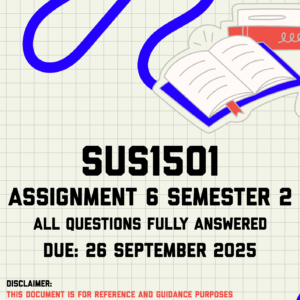
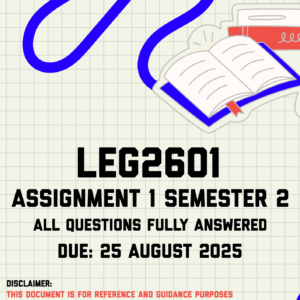




Reviews
There are no reviews yet.